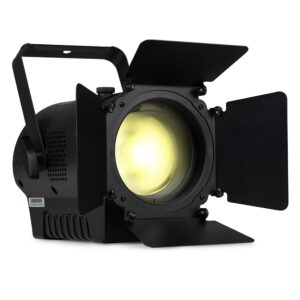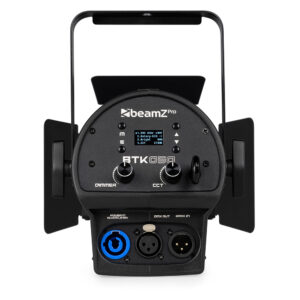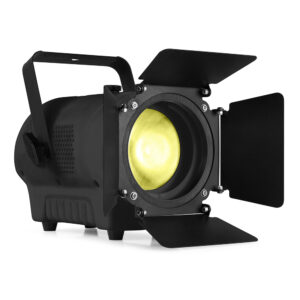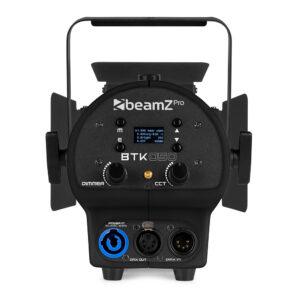Stage Spot Light
Precision Stage Spotlights and Theatre Fresnel Lights Engineered for High-Quality Lighting in Theatrical Performances.

Showing 1–18 of 21 results
Showing 1–18 of 21 results
Stage Spot Light
Spot lights emit a consistent and focused beam of unchanging illumination, making them highly suitable for various applications such as exhibitions, theatres, and live stage performances. With their ability to blend RGB colours, be controlled via DMX, respond to sound cues, and offer pre-programmed automated displays, our spotlights provide a dependable means to elevate your lighting setup.
Illuminating Performances with Theatre and Fresnel Spot Lights
Stage spot lights are essential elements in elevating the visual experience of performances, be it in a theatre, concert hall, or any live event. These dynamic lighting fixtures possess the power to enhance ambiance, direct focus, and evoke emotions, making them indispensable tools for directors, designers, and technicians.
Theatre spot lights are a staple in the world of stage lighting. These fixtures are known for their versatility and precision, enabling lighting professionals to create stunning effects that heighten the drama and atmosphere of a theatrical production. With their ability to control brightness, focus, and colour, these spot lights provide the flexibility needed to adapt to various scenes and moods, capturing the essence of the performance.
Fresnel spot lights, on the other hand, offer a unique lighting solution with their distinctive lens design. These fixtures produce a soft-edged, diffused light that creates a natural and flattering illumination on stage. These spot lights are often used to highlight specific actors or objects, providing a focused beam that can be easily adjusted to suit the desired effect. Their compact size and lightweight nature make them ideal for theatrical productions where mobility and flexibility are crucial.
Understanding Theatre Spot Lights
Theatre spot lights play a vital role in the world of live theatrical productions, as they are crucial for illuminating the stage and ensuring performers are well-lit and clearly visible to the audience. These specialised lighting fixtures are designed to provide a focused and controllable beam of light, allowing lighting designers to direct the audience’s attention to specific areas or actors on stage.
There are several types of theatre spot lights commonly used in theatrical productions. One such type is the Fresnel spot light. This type of spot light is known for its distinctive lens design, which allows for a soft-edged and diffused light output. This type of spot light is versatile and can be adjusted to create various lighting effects, making it ideal for highlighting specific actors or objects on stage.
Another commonly used spot light is the ellipsoidal spot light, often referred to as an “ellipsoidal” or “Leko” for short. Ellipsoidal spot lights are known for their precise beam control and ability to create sharp and well-defined edges. They are frequently used for spotlighting actors or creating precise lighting effects on stage.
Follow spots are another type of theatre spot light that are often used to track performers as they move across the stage. These spot lights are manually operated by a dedicated operator who adjusts the light’s position and intensity to follow the actor or actress, ensuring they are always in the spotlight.
Exploring Stage Spot Lights
Stage spotlights play a crucial role in creating a captivating and dynamic atmosphere during live performances, whether it’s a theatre production, music concert, or dance recital. These powerful beams of light are designed to highlight specific areas or performers on stage, adding depth, drama, and visual impact to the overall performance.
One of the key features of stage spotlights is their versatility. They can be adjusted to focus on a single performer, highlighting their every move and expression, or they can be used to create a sweeping wash of light across the stage, immersing the entire space in a particular colour or mood. Spot lights can also be equipped with different filters and lenses to create various effects, such as gobo projections or soft edges, further enhancing the visual spectacle.
The precise positioning and movement of spotlights are choreographed to match the rhythm and flow of the performance, seamlessly guiding the audience’s attention to the focal points on stage.
Stage spotlights are not just tools for illumination; they are storytellers in their own right. By manipulating light and shadow, spotlights can evoke different emotions and enhance the narrative of a performance. They can create a sense of mystery, build tension, or evoke a particular mood, making them particular effective for theatre and theme park lighting.
Key Features and Benefits of Stage Spot Lights
Stage spot lights possess a multitude of features and benefits that make them essential tools in the realm of live performances. These versatile lighting fixtures offer adjustable beam angles, allowing for precise focusing and beam shaping. Equipped with colour filters multi-colour LEDs, they empower lighting designers to craft vibrant and dynamic scenes. Moreover, modern lights integrate advanced control systems, facilitating seamless integration into complex lighting setups.
One of their primary features is their adjustable beam angles. This flexibility enables lighting professionals to precisely direct the light to specific areas or performers on stage. By adjusting the beam angle, they can highlight focal points, create dramatic effects, or evenly illuminate the stage as needed.
Colour filters or LEDs are commonly incorporated, providing a vast range of colour options. By placing these filters in front of the light source, lighting designers can effortlessly change the ambiance and mood of the performance. Whether it’s warm hues for a romantic scene or vibrant colours for a lively musical number, the ability to manipulate the colour of the light adds depth and visual impact to the production.
Furthermore, they now feature advanced control systems that facilitate seamless integration into complex lighting setups. These control systems allow for remote control, programming, and synchronisation with other lighting elements.
The benefits of these lights extend beyond their features. Their versatility enables them to adapt to various genres of live performances, from theatre productions to music concerts and dance performances. They provide a powerful means of directing attention, creating atmosphere, and enhancing the overall aesthetics of the stage.
Factors to Consider When Choosing Stage Spot Lights
Choosing the right stage spot lights involves considering several important factors to ensure optimal lighting for a performance. These factors include the required brightness output, the desired beam angle, the fixture’s power consumption, and its compatibility with existing lighting systems. Additionally, it is crucial to consider the venue’s size and layout, as well as the specific requirements of the production, to ensure the selected spot lights meet the unique demands of the performance.
The required brightness output is a key consideration when choosing stage spot lights. Different productions may require varying levels of brightness depending on the size of the venue and the desired visual impact. Assessing the lighting needs of the performance will help determine the appropriate brightness output of the spot lights to ensure visibility and clarity on stage.
The desired beam angle is another crucial factor to consider. The beam angle determines the spread and focus of the light.
Narrow beam angles provide a concentrated and focused light, ideal for highlighting specific areas or performers, while wider beam angles offer broader coverage for general stage lighting. Understanding the specific lighting requirements of the production will guide the selection of spot lights with the appropriate beam angle.
Compatibility with existing lighting systems is crucial for seamless integration and efficient control of the lighting setup. Spot lights should be compatible with the control protocols and consoles already in use to ensure smooth communication and synchronisation with other lighting fixtures. This enables cohesive lighting design and coordinated lighting cues during the performance.
Lastly, considering the size and layout of the venue, as well as the specific requirements of the production, is essential. Different venues may have varying architectural features and lighting challenges that need to be addressed. Understanding the unique aspects of the space and the specific lighting demands of the production will help in selecting spot lights that can effectively illuminate the stage and enhance the overall visual experience.
Maintenance and Safety Guidelines for Stage Spot Lights
Maintaining stage spotlights and adhering to safety protocols are essential for the long-term functionality of the equipment and the well-being of those involved in live performances. To achieve this, proper maintenance practices and safety guidelines must be implemented. Regular cleaning of the fixtures using recommended tools and solutions is necessary to remove dust and debris that can affect performance.
Before cleaning, it is important to ensure that the lights are turned off and disconnected from the power source. Additionally, inspecting cables and connectors for wear, fraying, or damage is crucial. Promptly replacing any damaged components can prevent electrical hazards or interruptions during performances. It is also important to regularly check the condition of bulbs in the spotlights and replace any worn-out or damaged bulbs to maintain optimal lighting quality.
Adhering to electrical safety protocols, such as connecting spotlights to appropriate power sources, proper grounding, avoiding circuit overloading, and using surge protectors when necessary, is vital.
To ensure safety, it is recommended to establish a regular inspection schedule to identify potential hazards. Thorough inspections of cables, connectors, housing, and mounting hardware should be conducted. It is advisable to assign maintenance and repair tasks to qualified personnel with expertise in electrical safety and spotlights.
Always follow the manufacturer’s guidelines for maintenance, cleaning, and operation of the spotlights, including recommended cleaning products, bulb types, and specific maintenance procedures. Keeping detailed records of maintenance activities, repairs, and inspections is important. These records serve as references for future maintenance and help track the equipment’s history.





























